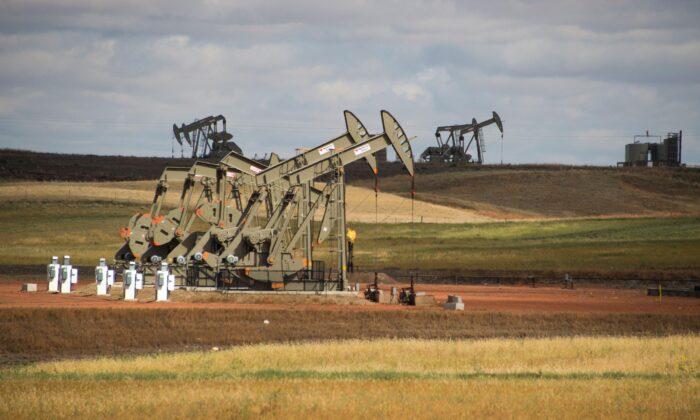U.S. oil prices plunged to unprecedented negative numbers on April 20 as a lack of storage space and weak demand forced oil producers and traders into the bizarre situation of paying anybody willing to take the oil.
The price of West Texas Intermediate (WTI), the leading U.S. oil price index, to be delivered in May dropped at one point to about negative $40 a barrel, before somewhat rebounding to negative $37.63.
The negative price was caused by traders who realized that there’s going to be a severe lack of capacity to store the oil about to be pumped out in the coming weeks. The market quickly reached a point where storage became more valuable than the oil itself.
Contracts to buy oil produced in May need to be closed by April 21 on the Chicago Mercantile Exchange (CME). Traders who speculate on oil prices close such contracts with no intention of obtaining the physical oil. Instead, they plan to sell the contracts later, hopefully at a higher price. As the deadline approached, it became clear how scarce were buyers who can actually take deliveries of the oil. Speculators stuck with the contracts thus went into a frenzy to unload them.
“This is a reminder that you never say never in oil,” said Phil Flynn, senior analyst at The PRICE Futures Group. “Those that said that WTI would never trade negative were proven wrong from the coronavirus.”
It’s the “crazy times,” he said in an email, where there’s “more oil to deliver than anyone wants.”
Industry in Distress
The rock-bottom oil prices threaten to wipe out a major part of the U.S. oil industry. WTI has been below $20 for nearly a week now, while producers need it on average above $30 to at least cover operating expenses for existing wells.Pandemic Effect
The CCP (Chinese Communist Party) virus, also called novel coronavirus, broke out in the central Chinese city of Wuhan around November 2019, before spreading across China and the world.By April 20, there have been over 2.47 million confirmed cases and nearly 170,000 deaths, with many more likely in countries with unreliable data.
The pandemic prompted governments to impose stay-at-home orders and business shutdowns that forced millions into unemployment. With economic slowdown, demand for oil plummeted, leaving oilers scrambling to cut costs and production.
“Because producers have been lagging in their production cuts, we’re seeing an overwhelming amount of crude oil looking for a place to go around the world,” said Andy Lipow of Lipow Oil Associates.
Crude stockpiles at the oil trading hub in Cushing, Oklahoma, rose 9 percent in the week to April 17, totaling around 61 million barrels, market analysts said, citing an April 20 report from Genscape.
Price War
The glut has been exacerbated by a price war between Russia and Saudi Arabia that started after Russia walked away from talks on production cuts with the Organization of Petroleum Exporting Countries (OPEC) in early March. Both countries then escalated production, flooding the already shrinking market.Moscow, Riyadh, and other major oil producers have since agreed to cut production by 9.7 million barrels a day, but those cuts don’t begin until May. Meanwhile, Saudi Arabia is ramping up deliveries of oil, including big shipments to the United States.
Filing the Reserve
To prop up the industry, President Donald Trump has ordered the filling of the Strategic Petroleum Reserve (SPR), which can hold about 700 million barrels, but only stored some 635 million in January.Yet, the $3 billion earmarked for filling the SPR was cut from the coronavirus stimulus package by Democrat legislators, who criticized it as a “big oil” bailout.
On April 14, the Energy Department announced contracts with nine oil companies to store oil for them in the SPR.
“Awardees can schedule return of their oil through March 2021, minus a small amount of oil to cover the SPR’s cost of storage.”






Friends Read Free